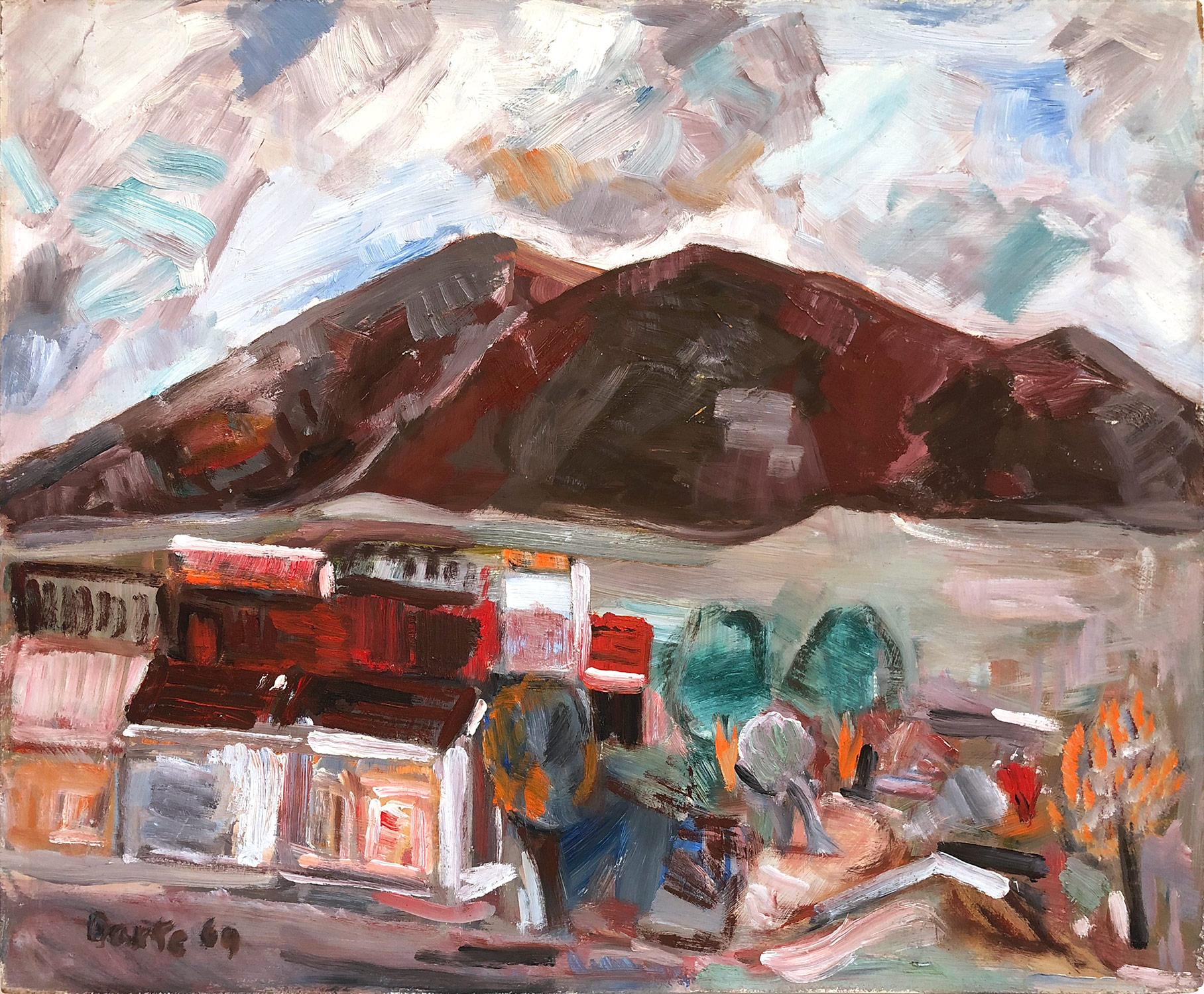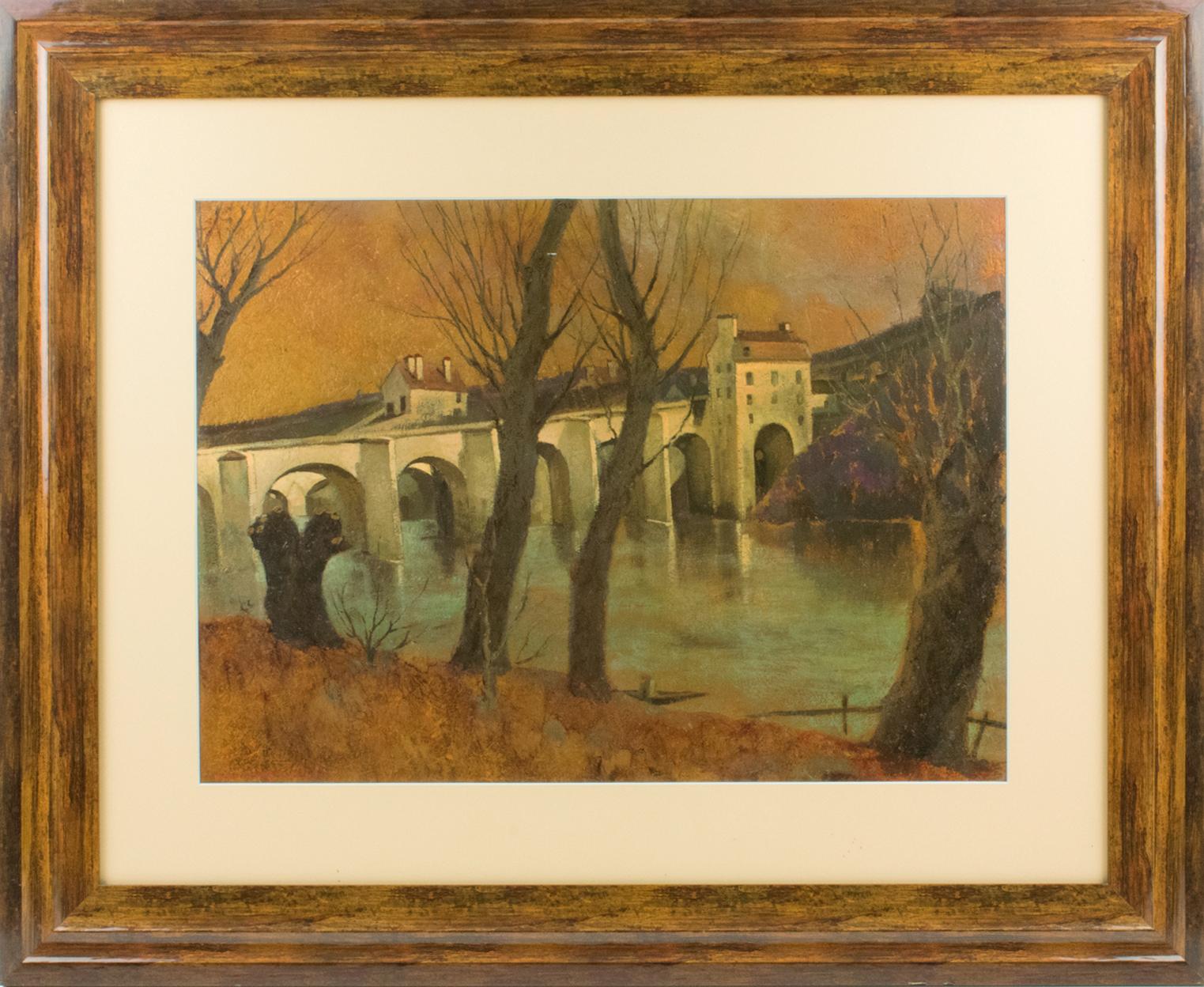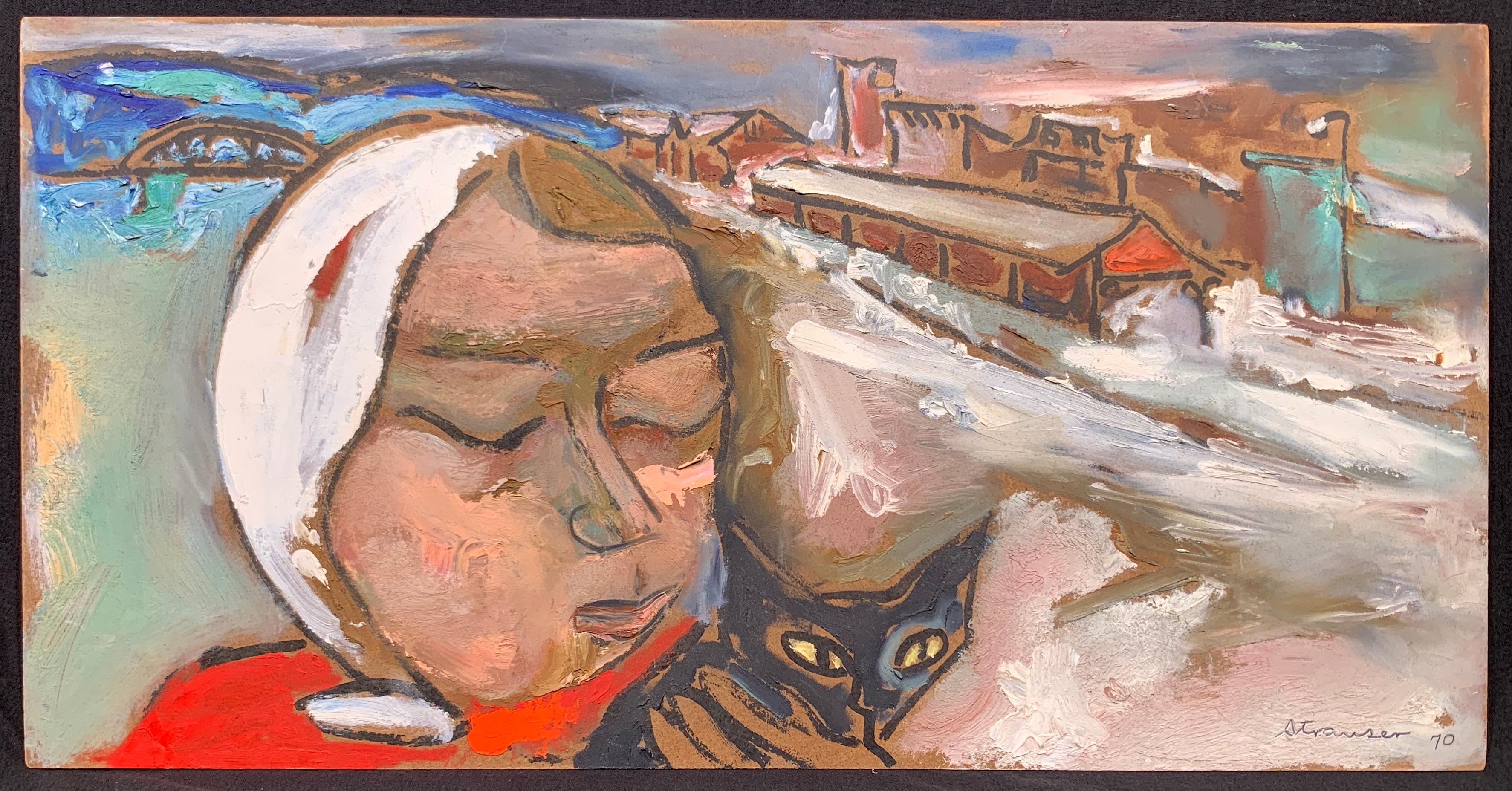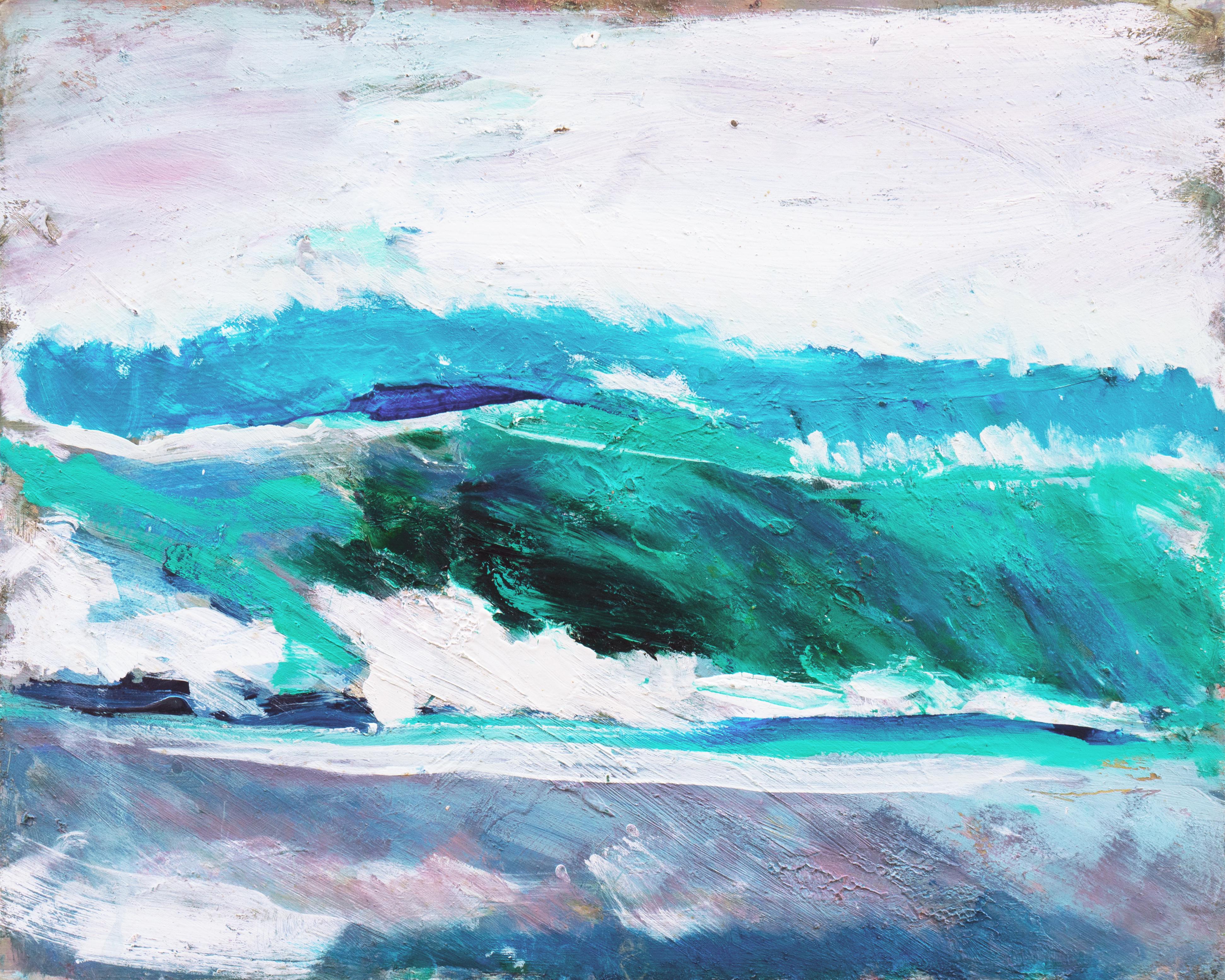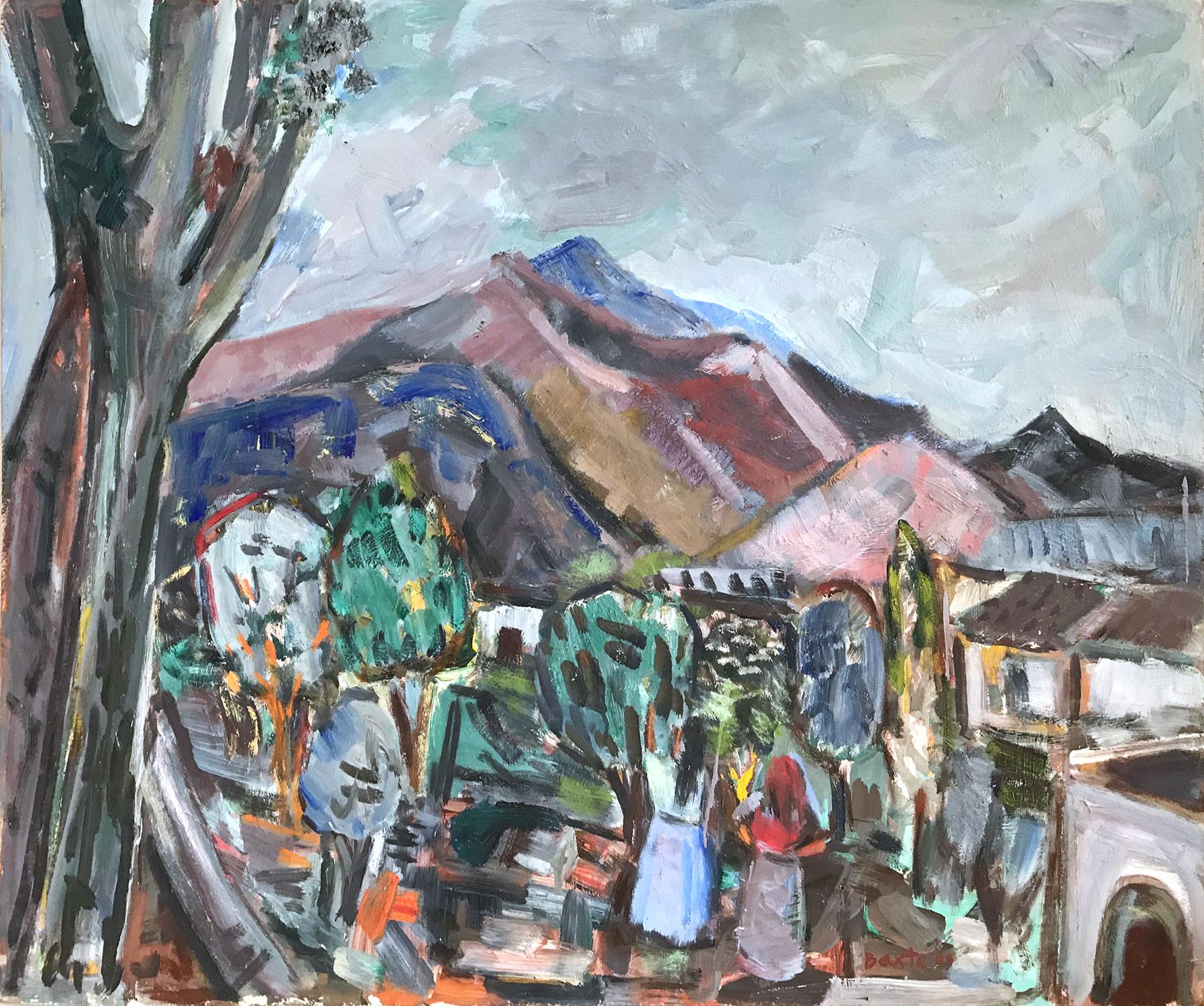Items Similar to "Colorful Mexican Village Scene" Expressionistic Oil Painting on Masonite
Want more images or videos?
Request additional images or videos from the seller
1 of 15
Michael Baxte"Colorful Mexican Village Scene" Expressionistic Oil Painting on MasoniteCirca 1960
Circa 1960
About the Item
A strong modernist oil painting depicted Circa 1960 by Russian painter Michael Baxte. Mostly known for his abstracted figures on canvas or street scenes, this piece is a wonderful representation of his bold still life paintings, with expressive use of color, shape, and form. Later in his career, Baxte explores Expressionism, infusing both European and North American stylistic trends. This piece is from later in his career, but we can feel this underlying style throughout.
Art measures 18 x 21.75 inches
Michael Posner Baxte was born in 1890 in the small town of Staroselje Belarus, Russia. For the first half of the 19th century it was a center of the Chabad movement of Hasidic Jews, but this group was gone by the middle of the 19th century. By the time the Baxte family immigrated to the United States at the beginning of the 20th century, the Jewish population numbered only on the hundreds. The native language of the Baxte family was Yiddish. It is likely that the death of Michael Baxte’s father triggered the family’s immigration. Three older brothers arrived in New York between 1903 and 1905. Michael and his mother, Rebecca, arrived in 1907. By 1910 Michael, his mother, and brother, Joseph, were living in New Orleans and may have spent some time on a Louisiana plantation. Around 1912, Michael Baxte returned to Europe to study the violin. In 1914 he, his mother, and Joseph moved to New York City.
Meanwhile, in Algeria, a talented young woman painter, Violette Mege, was making history. Since for the first time, a woman won the prestigious Beaux Art competition in Algeria. At first, the awards committee denied her the prize but, with French government intervention, Mege eventually prevailed. She won again 3 years later and, in 1916, used the scholarship to visit the United States of America. When Violette came to New York, she met Baxte, who was, by then, an accomplished violinist, teacher, and composer. Baxte’s compositions were performed at the Tokyo Imperial Theater, and in 1922 he was listed in the American Jewish Yearbook as one of the prominent members of the American Jewish community. As a music teacher he encouraged individual expression. Baxte stated, “No pupil should ever be forced into imitation of the teacher. Art is a personal experience, and the teacher’s truest aim must be to awaken this light of personality through the patient light of science.”
By 1920 Michael Baxte and Violette Mege were living together in Manhattan. Although they claimed to be living as husband and wife, it seems that their marriage did not become official until 1928. On their “unofficial” honeymoon around 1917, in Algiers, Baxte confided to her his ambition to paint. There and later in New Mexico where the wonderful steeped sunlight approximates the coloring of Algiers, she taught him his heart’s desire. He never had any other teacher. She never had any other pupil. For ten years she devoted all her time, energy, and ambition to teaching, encouraging, inspiring him. Then in 1928, their mutual strivings were rewarded, as his works were being chosen as one of the two winners in the Dudensing National Competition for American Painters. Out of 150 artists from across the country participated in the Dudensing, and Michael Posner Baxte and, Robert Fawcett, were the winners.
In his 1924 naturalization application, he indicated that he was sometimes known as “Michael Posner Baxte.” One of the witnesses to his application was Bernard Karfiol, a Jewish American artist. That’s when Michael may have decided to use the name Baxte for his art. Baxte, née Posner, received critical acclaim from art critics. In 1929, Lloyd Goodrich of The New York Times wrote, “Mr. Baxte has a way of choosing aspects of the world that are quite unhackneyed… He is an artist of considerable subtlety, not too strong perhaps, and sometimes a little uncertain, but always sensitive and interesting. One feels in each of his pictures an absorption in his subject and an individual manner of looking at it. He has a very attractive color sense, warm, sensuous, and unexpected, which seems natural and unforced.” A dozen years later another New York Times art critic, Howard Devree, commented, “Also at the Bonestell are paintings by Michael Baxte, who lays in his color with gusto and considerable acumen.”
During the 1930’s Baxte and his wife, Violet, lived in France and spent most of their time in Paris, where Baxte became part of the School of Paris and exhibited his artwork in government sponsored exhibitions including the Salon d' Automme, helping as well to organize an exhibition of American painters. When the World War II began, and Paris became unsafe Baxte and his wife relocated to Mexico where they continued to live and work. Baxte died in 1972 in Mexico.
PROVENANCE: Private collection; Lilac Gallery Collection. The piece will be stamped from Lilac Gallery on its verso.
- Creator:Michael Baxte (1890 - 1972, Russian)
- Creation Year:Circa 1960
- Dimensions:Height: 18 in (45.72 cm)Width: 21.75 in (55.25 cm)Depth: 0.25 in (6.35 mm)
- Medium:
- Movement & Style:
- Period:
- Condition:This piece is in very condition besides some wear on the outer edge of the board from age and some noticeable water damage on the back of the board that did not affect the front of the artwork.
- Gallery Location:New York, NY
- Reference Number:
About the Seller
5.0
Platinum Seller
These expertly vetted sellers are 1stDibs' most experienced sellers and are rated highest by our customers.
Established in 2012
1stDibs seller since 2015
1,463 sales on 1stDibs
Typical response time: 1 hour
- ShippingRetrieving quote...Ships From: New York, NY
- Return PolicyA return for this item may be initiated within 7 days of delivery.
More From This SellerView All
- "Landscape Scene of Mexican Villagers" Expressionistic Oil Painting on MasoniteBy Michael BaxteLocated in New York, NYA strong modernist oil painting depicted in 1971 by Russian painter Michael Baxte. Mostly known for his abstracted figures on canvas or street scenes, this piece is a wonderful representation of his landscape paintings, with expressive use of color, shape, and form. Later in his career, Baxte explores Expressionism, infusing both European and North American stylistic trends. This piece is from later in his career, but we can feel this underlying style throughout. Art measures 18 x 21.75 inches Michael Posner Baxte was born in 1890 in the small town of Staroselje Belarus, Russia. For the first half of the 19th century it was a center of the Chabad movement of Hasidic Jews, but this group was gone by the middle of the 19th century. By the time the Baxte family immigrated to the United States at the beginning of the 20th century, the Jewish population numbered only on the hundreds. The native language of the Baxte family was Yiddish. It is likely that the death of Michael Baxte’s father triggered the family’s immigration. Three older brothers arrived in New York between 1903 and 1905. Michael and his mother, Rebecca, arrived in 1907. By 1910 Michael, his mother, and brother, Joseph, were living in New Orleans and may have spent some time on a Louisiana plantation. Around 1912, Michael Baxte returned to Europe to study the violin. In 1914 he, his mother, and Joseph moved to New York City. Meanwhile, in Algeria, a talented young woman painter, Violette Mege, was making history. Since for the first time, a woman won the prestigious Beaux Art competition in Algeria. At first, the awards committee denied her the prize but, with French government intervention, Mege eventually prevailed. She won again 3 years later and, in 1916, used the scholarship to visit the United States of America. When Violette came to New York, she met Baxte, who was, by then, an accomplished violinist, teacher, and composer. Baxte’s compositions were performed at the Tokyo Imperial Theater, and in 1922 he was listed in the American Jewish Yearbook as one of the prominent members of the American Jewish community. As a music teacher he encouraged individual expression. Baxte stated, “No pupil should ever be forced into imitation of the teacher. Art is a personal experience, and the teacher’s truest aim must be to awaken this light of personality through the patient light of science.” By 1920 Michael Baxte and Violette Mege were living together in Manhattan. Although they claimed to be living as husband and wife, it seems that their marriage did not become official until 1928. On their “unofficial” honeymoon around 1917, in Algiers, Baxte confided to her his ambition to paint. There and later in New Mexico where the wonderful steeped sunlight approximates the coloring of Algiers, she taught him his heart’s desire. He never had any other teacher. She never had any other pupil. For ten years she devoted all her time, energy, and ambition to teaching, encouraging, inspiring him. Then in 1928, their mutual strivings were rewarded, as his works were being chosen as one of the two winners in the Dudensing National Competition for American Painters. Out of 150 artists from across the country participated in the Dudensing, and Michael Posner Baxte and, Robert Fawcett, were the winners. In his 1924 naturalization application, he indicated that he was sometimes known as “Michael Posner Baxte.” One of the witnesses to his application was Bernard Karfiol, a Jewish American artist. That’s when Michael may...Category
1960s Expressionist Landscape Paintings
MaterialsMasonite, Oil
- "Mexican Countryside Landscape Mountain Scene with Trees" Expressionistic StyleBy Michael BaxteLocated in New York, NYA strong modernist oil painting depicted in 1962 by Russian painter Michael Baxte. Mostly known for his abstracted figures on canvas or street scenes, this piece is a wonderful repre...Category
1960s Expressionist Landscape Paintings
MaterialsMasonite, Oil
- "Mexican Outdoor Scene with Figures" Expressionistic Style Oil Painting on BoardBy Michael BaxteLocated in New York, NYA strong modernist oil painting depicted in the Mid Century by Russian painter Michael Baxte. Mostly known for his abstracted figures on canvas or street scenes, this piece is a wond...Category
1960s Expressionist Landscape Paintings
MaterialsOil, Masonite
- "Pescadores" Expressionistic Style Mexican Scene by the Water with FishermenBy Michael BaxteLocated in New York, NYA strong modernist oil painting depicted in the Mid Century by Russian painter Michael Baxte. Mostly known for his abstracted figures on canvas or street scenes, this piece is a wond...Category
1950s Expressionist Landscape Paintings
MaterialsOil, Masonite
- "Mexican Landscape Water Scene with Figures and Boat" Expressionistic StyleBy Michael BaxteLocated in New York, NYA strong modernist oil painting depicted in the Mid Century by Russian painter Michael Baxte. Mostly known for his abstracted figures on canvas or street scenes, this piece is a wond...Category
Mid-20th Century Expressionist Landscape Paintings
MaterialsMasonite, Oil
- "Mexican Landscape Scene with Female Figures and Child" Expressionistic StyleBy Michael BaxteLocated in New York, NYA strong modernist oil painting depicted in the Mid Century by Russian painter Michael Baxte. Mostly known for his abstracted figures on canvas or street scenes, this piece is a wond...Category
1970s Expressionist Figurative Paintings
MaterialsOil, Masonite
You May Also Like
- Vaulted Bridge in French Landscape Oil on Wood Painting by Vincent MazzocchiniLocated in Atlanta, GAVincent Mazzocchini (France, 20th Century) created this unique French landscape oil on pressed wood board painting. This delightful composition is on rather unusual media. The lands...Category
1940s Expressionist Landscape Paintings
MaterialsWood, Masonite, Oil
- Winter Walk with Jasper, (Black Cat painting)By Sterling Boyd StrauserLocated in Wilton Manors, FLSterling Strauser (1907-1995). Dorothy and Jasper, Crystal Street Station, 1970. Oil on masonite panel, 11.5 x 22.25 inches. Signed and dated lower right. Very good condition with no damage or conservation. Unframed. Framing services available. Image depicts the artist's wife, Dorothy Strauser, walking the beloved family cat, Jasper. In the background can be seen the East Stroudsburg Pa Train Depot on Crystal Street. Provenance: Estate of the artist's Granddaughter, Princeton NJ. Often called a romantic expressionist and American intimist, self-taught Pennsylvania artist Sterling Strauser (1907-1995) completed his first oil painting in 1922- inspired by frequent visits to the collection of American folk art at the Everhardt Museum in Scranton. Throughout the following seven decades of his career, Strauser’s artistic pursuit was based on his own intuition and determination to paint what he saw, rather than adhering to the conventional pictorial structures prescribed by prevailing styles at the time. Strauser rejected pretension, believing instead that art should work from life as it was lived. His oeuvre therefore serves as an extremely personal record of his observations and experiences from his lifetime painting in East Stroudsburg, Pennsylvania. Beginning early in his career, Strauser took his inspiration from American regionalists and traditional realists in the Ashcan style, as well as European movements such as Fauvism and Cubism, yet he eventually developed his own fluid realism based on subject matter beloved and familiar to him- family and friends, local landscapes and floral still lifes. Known for his distorted pictorial space, exaggerated with vivid color, heavy impasto and an intensity of emotion, Strauser was adept at altering and rearranging the details and aspects of any given form to create a new kind of beauty. "All a painting has to do, or a piece of sculpture, or whatever, is to entertain the critical eye. You have to have a fresh seeing eye… to look at things like a child, as if looking at the world for the first time (seeing) something that somebody else doesn’t see, something you want to identify with… Painting is largely a matter of evaluation. (It) doesn’t matter how much it looks like the subject matter. It just depends on how interesting you have made it so that it pleases the critical eye." STERLING STRAUSER, STERLING STRAUSER: A MODERNIST REVISTED, P. 23 Sterling exhibited his work extensively throughout the country and drew the attention of many notable fellow artists including Milton Avery, Louise Nevelson, David Burliuk, Chaim Gross and Red Grooms. Sterling was also extremely influential within the arts community of Pennsylvania through his discovery and promotion of self-taught American Folk artists such as Justin McCarthy, Jack Savitsky, Joseph Gatto...Category
Mid-20th Century Expressionist Landscape Paintings
MaterialsMasonite, Oil
- 'Breaking Waves Off Monterey', California Expressionist Oil Seascape, CarmelBy Robert CaneteLocated in Santa Cruz, CASigned lower left "Canete" for Robert Canete (American, born 1948), and painted circa 1990. This Carmel artist first studied with Vincent Rascon in the 1960s and, later, with Dwight ...Category
1980s Expressionist Landscape Paintings
MaterialsMasonite, Oil
- Expressionism, Extergem, Sea, Palms, Cote D'Azur, 1921, Summer Coast SceneLocated in Greven, DEPainting of a Beach Promenade, with Palm Trees, perhaps the City of Nice nearby. The painting is signed and dated 1921. The artist Guido Van Extergem is o...Category
20th Century Expressionist Landscape Paintings
MaterialsOil, Plywood
- Village of Iseh, Bali (1948)By Theo MeierLocated in Amsterdam, NLTheo Meier (1908-1982) View of the Village of Iseh, painted from the house of Theo Signed and dated 48 Theo Meier lower left Oil on canvas, 68.5 x 50 cm In original frame carved by the artist. Note: Theo Meier arrived in Bali in 1936 with the intention of going on to Tahiti where he had been before. However Bali turned out to be the paradise he had been searching for in his dreams and he had no desire any more to move elsewhere. Bali at that time was still a very traditional place where society lived according to an acient religious system and in a luscious tropical setting the modern world was ignored. Here he met Walter Spies...Category
Mid-20th Century Expressionist Landscape Paintings
MaterialsCanvas, Rosewood, Oil
- CaféBy Frederick B. SergerLocated in Wien, 9Frederick B. Serger (1889 - 1965) studied at the art schools in Brno and Vienna and later in Munich. After the First World War he went to Paris where he continued his art studies an...Category
20th Century Expressionist Landscape Paintings
MaterialsWood, Oil
Recently Viewed
View AllMore Ways To Browse
19th Century Mexican Oil Paintings
19th Century Violin
Small 1890s Painting
1910s Russia
Violin Still Life
Dior Violet
Small 1910s Painting
Rebecca Well
Still Life With Violin
Rebecca Of The Well
Rebecca Of Wells
Rebecca At The Well
Dior Lilac
Used Yearbooks
France 1960 Street Light
Algerian Woman
Louisiana Plantation
Yiddish Theater
